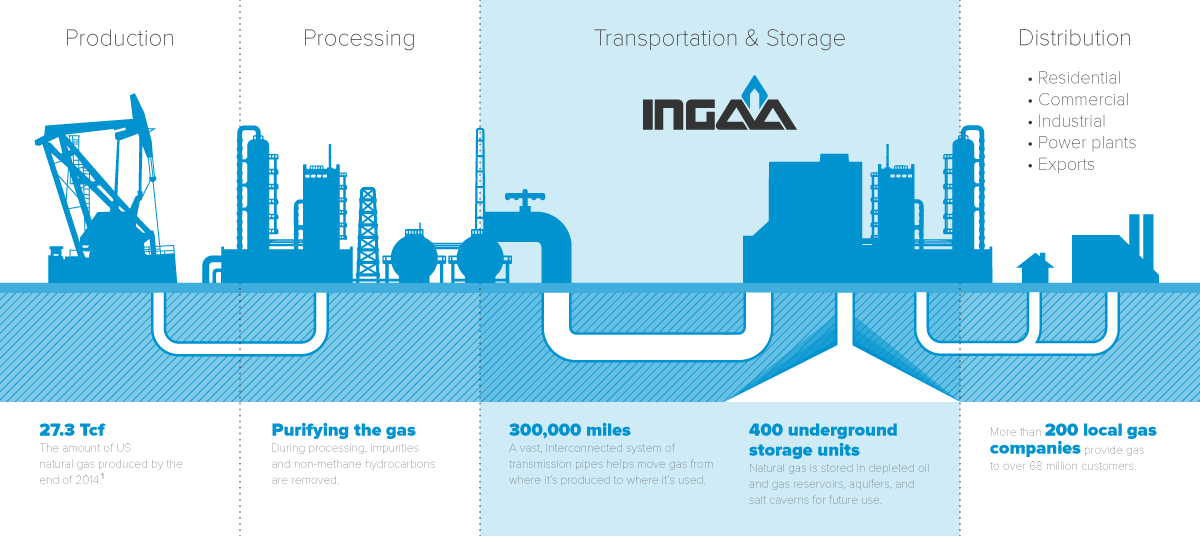Operations
Pipelines are the critical link that allows abundant natural gas production to make its way to consumers, and our priority is to deliver this gas safely and reliably every day.

In addition to the pipe itself, compressor stations, which are located about every 40-100 miles along an interstate transmission system, are critical infrastructure key to making a pipeline operate. These systems compress the natural gas in the pipe and send it, at an average speed of 10-20 mph, through the pipeline, ensuring the gas flows at a consistent rate.
To properly manage its gas pipeline system efficiently, pipeline operators must at all times know exactly how much gas is in its system. With some interstate pipeline systems extending more than 1,000 miles, this can be a daunting task. Pipeline companies use metering stations to measure all natural gas entering or exiting the pipeline system. Some metering stations also regulate gas pressure and delivery volumes. Pressure regulation equipment ensures that gas delivered into or out of a pipeline system stays within a specified safe-pressure range.
Pipeline companies install valves along a gas pipeline system to control the flow. The valves may be spaced as close together as every five miles or as far apart as every 20 miles, according to standards established by safety codes. The valves normally remain open, but when a section of pipeline requires maintenance, operators close the valves to isolate that section of the pipeline. Once isolated, the maintenance crew can vent, or release, the gas from that section of the pipeline and proceed with its repairs. Additionally, operators are now required to install automated and remote controlled valves for all newly constructed pipelines and entirely replaced segments. These valves can be quickly closed in the event of an incident.
In the event of an emergency, be it a natural disaster, physical attack, cyber incident, or other event that might affect pipeline operations, INGAA is routinely called upon by our federal partners at DOE, FERC, TSA, and CISA to assess issues, anticipate recovery timelines, and discuss potential federal responses that might facilitate a timelier return to normal operations. INGAA facilitates discussions among our members prior to, during, and immediately following emergency situations in order to effectively communicate real-time, appropriate information to internal and external partners.
Storage facilities are another way the industry can help ensure that gas is available when it is needed most — on cold winter or hot summer days, or when there is a disruption of supply because of an emergency, such as a hurricane. Most natural gas storage fields are depleted gas reservoirs; others are underground caverns in salt domes. Because natural gas storage is dependent on geological formations, storage cannot be placed everywhere.
Yes. Pipelines are the safest, most reliable and efficient manner of transporting energy products.
The Department of Transportation, or DOT, oversees interstate natural gas pipelines, and they often note that pipelines are the safest form of energy transportation. Statistics gathered by the National Transportation Safety Board, a federal agency, indicate that pipelines make up less than one one-hundredth of one percent (.01%) of all transportation accidents in the United States. There are approximately 300,000 miles of natural gas transmission pipelines throughout the United States that deliver safe, reliable natural gas to American families and businesses.
Pipelines exist almost everywhere throughout the United States -generally buried underground – transporting the energy that you depend on every day to heat your home, generate electricity, cook your food and so much more. Pipelines are a vital and efficient part of the United States’ energy infrastructure.
As with any surface, the inner walls of our pipelines are not perfectly smooth which leads to some friction when a product like natural gas flows through them. Even a small amount of friction will cause some pressure loss after the natural gas has passed through the pipeline for many miles.
A pipeline company must install compressors along the pipeline to re-pressure the natural gas so it may continue to flow. Compressor stations are typically installed at intervals of 30 to 70 miles (approximately 48 to 112 kms) along the pipeline.
When natural gas is first transported through transmission lines it can be passed through at varying pressures depending on the individual pipeline and location. By the time it reaches a household piping system at your local gas company, pressure has been reduced to less than the pressure created by a child blowing bubbles into milk through a straw.
A pipeline company must install compressors along the pipeline to re-pressure the natural gas so it may continue to flow to the end user. Compressor stations are typically installed at intervals of 30 to 70 miles (approximately 48 to 112 kilometers) along the pipeline.
The following are a few of the agencies that regulate natural gas pipelines:
The Federal Energy Regulatory Commission (FERC) regulates such things as natural gas transportation rates, pipeline capacity, pipeline siting and natural gas quality requirements.
The U.S. Department of Transportation (DOT) Pipeline and Hazardous Materials Safety Administration (PHMSA) and their state and local agents provide regulation for the safe transportation of natural gas through pipelines.
The U.S. Environmental Protection Agency (EPA), the Fish and Wildlife Service and state environmental protection agencies provide regulations for protection of the environment and cultural resources during the construction and operation of pipeline facilities.
The U.S. Occupational Safety and Health Administration (OSHA) provides regulation for the safe working place for personnel.
Natural gas pipeline easements have had little or no effect on property values historically.
Integra Realty Resources, a leading provider of real estate valuation and counseling services, conducted a rigorous study of properties in four separate areas of the country in 2015. The report, Pipeline Impact to Property Value and Property Insurability, prepared on behalf of the INGAA Foundation, shows that the presence of pipelines does not affect the value of a property, its insurability, its desirability or the ability to obtain a mortgage.
The Federal Energy Regulatory Commission is charged by Congress with evaluating whether interstate natural gas pipeline projects proposed by private companies should be approved. The federal government does not propose, construct, operate, or own such projects. The commission’s determination whether to approve such a project may affect you if your land is where a natural gas pipeline, other facilities, or underground storage fields might be located. FERC has issued a handy guide, An Interstate Natural Gas Facility on My Land? What Do I Need to Know?, for your information.
This guide covers:
How the Federal Energy Regulatory Commission’s procedures work;
What rights landowners have;
How the location of a pipeline or other facilities is decided;
What safety and environmental issues might be involved.
INGAA’s members live and work in these communities where projects are built and have committed to having a long-term relationship as your neighbor. INGAA members affirmed its commitments to landowners in a document called ‘America’s Natural Gas Transporters’ Commitment to Landowners.’
Think of a natural gas pipeline as an energy highway. American pipelines transport natural gas from nearly 275,000 gas wells in various production areas of the country over hundreds or thousands of miles to customers in cities, towns and industrial facilities.
The gas is compressed when it comes out of the wells, and this compression helps it move at about 15 miles per hour through the pipes. Though the friction of the gas against the pipes slows it down at some points along the way, the pipelines operate compressor stations at points about 75 miles apart along the route to compress the natural gas and then push it along. The natural gas in a pipeline is roughly the same temperature as the earth around the pipeline, though the periodic compression can increase the temperature for a short distance.
The gas moves relatively quietly on its journey through the pipeline system. The only noise comes at the compressor stations, whose motors generate the equivalent noise of a plane engine. To minimize noise, compressor stations, which are about the size of a barn, are insulated and operate under federal regulations and specifications. Natural gas is delivered to local gas distribution companies (LDCs), which in turn distribute the gas to homes, businesses and factories. Pipelines also deliver gas to end-users, such as electric generators.




